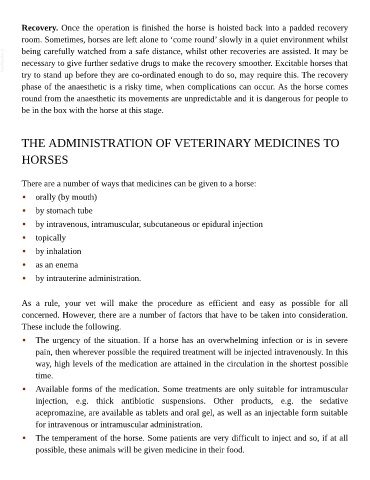Page 1093 - The Veterinary Care of the Horse
P. 1093
Recovery. Once the operation is finished the horse is hoisted back into a padded recovery
room. Sometimes, horses are left alone to ‘come round’ slowly in a quiet environment whilst
VetBooks.ir being carefully watched from a safe distance, whilst other recoveries are assisted. It may be
necessary to give further sedative drugs to make the recovery smoother. Excitable horses that
try to stand up before they are co-ordinated enough to do so, may require this. The recovery
phase of the anaesthetic is a risky time, when complications can occur. As the horse comes
round from the anaesthetic its movements are unpredictable and it is dangerous for people to
be in the box with the horse at this stage.
THE ADMINISTRATION OF VETERINARY MEDICINES TO
HORSES
There are a number of ways that medicines can be given to a horse:
• orally (by mouth)
• by stomach tube
• by intravenous, intramuscular, subcutaneous or epidural injection
• topically
• by inhalation
• as an enema
• by intrauterine administration.
As a rule, your vet will make the procedure as efficient and easy as possible for all
concerned. However, there are a number of factors that have to be taken into consideration.
These include the following.
• The urgency of the situation. If a horse has an overwhelming infection or is in severe
pain, then wherever possible the required treatment will be injected intravenously. In this
way, high levels of the medication are attained in the circulation in the shortest possible
time.
• Available forms of the medication. Some treatments are only suitable for intramuscular
injection, e.g. thick antibiotic suspensions. Other products, e.g. the sedative
acepromazine, are available as tablets and oral gel, as well as an injectable form suitable
for intravenous or intramuscular administration.
• The temperament of the horse. Some patients are very difficult to inject and so, if at all
possible, these animals will be given medicine in their food.

